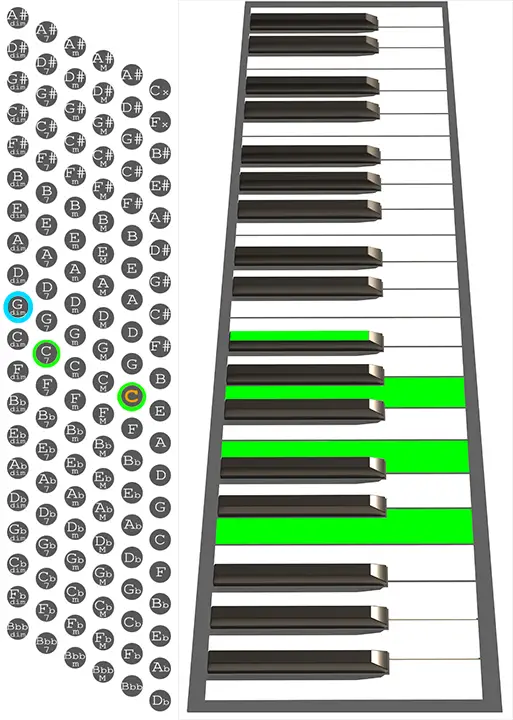AKA: C7, C Dom, C dom7, C Dominant 7th, C Dominant seventh
C7 Chord Chart

7th Chords
Dominant seventh chords can be constructed in several different ways, including by stacking thirds (a Major 3rd + minor 3rd + minor 3rd), or by using the interval of a minor seventh above the root of the chord.
For example: G7 = G, B, D, F (Root, 3rd, 5th, m7th) where G-B is a Major 3rd, B-D is a minor 3rd and D-F is a minor 3rd
These chords are often used to add color and interest to harmonic progressions. They can add tension and be resolved to create a sense of resolution and satisfaction. A II-V-I chord progression in the key of C, for example, would consist of a D minor (II), a G7 (V), and a C Major (I). The G7 chord creates tension that suggests the resolution to the C major chord, creating a sense of movement and direction in the progression.
Try to play a II-V-I as D min, G Maj, C Maj and then as D min, G7 and C Maj. Can you feel the difference? When you play the G7 chord, you should be able to hear the tension created by the F in the chord, which calls for resolution to the E in the following C major chord. This tension and resolution is what gives the II-V-I progression its sense of movement and direction.
7th Chord Buttons
The 7th chord buttons on Stradella bass system (dom 7th & dim 7th) play just the root, the 3rd, and the 7th.
In other words, dominant 7th and diminished 7th chords buttons on the Stradella bass system, don’t play the 5th.
To play a full dominant seventh chord, you would need to play the diminished chord one row above the root on the bass buttons as shown in the chart. This diminished chord, when played with the root of the dominant seventh chord, will provide the missing fifth and complete the chord.
Root + 7th chord: G + G7 = G + G, B, F (Root, 3rd, m7th)
Root + Dim chord: G + D dim = G + D, F, B (Root, 5th, m7th, 3rd)

Notes:
C, E, G, B♭
C7 button plays:
C, E, B♭ (no G)
Intervals:
R, 3°, 5°, m7°
7th chord buttons play:
R, 3°, m7° (no 5°)
Left hand:
Root + 7th chord: C7(omit5)
C + C7
Root + Dim chord: C7
C + G dim
Fingering:
4 + 2
The 6th chapter shows 6th Major chords.
Why don’t you show 6th minor chords, please
Thanks a lot for your very interesting website
Hi Marc,
thank you so much for your appreciation!
I avoided listing 6th minor chords because diminished 7th bass chords on the accordion correspond also to Minor 6th chords.
Take a look at Diminished Chords: “The diminished chord buttons on the accordion actually are diminished 7th chords without the 5th, this means that they play just the root, the minor 3rd, and the diminished 7th (which is also a 6th).”
For example Cdim = C + Eb + A which is also a Cm6 (5th omit).
You could play a complete Cm6 (C + Eb + G + A) playing C bass + Cm chord + Cdim chord but I suggest playing just C bass + Cdim chord for both diminished and minor 6th chords.
Hello!
I’m learning the accordion because my school had one and I’m having a problem with the limited range of mine. My accordion only has 4 columns: counter-bass, bass root, and major then minor chords. How would I play more complex chords like major 7th, and if possible could I modify the accordion by sending it to a shop ti add more buttons? Thanks!
Hello Mike,
You can explore the 48 bass (12×4) chart. This chart provides a comprehensive list of the most common chords that you can play on your accordion. Additionally, you might find the list of Major 7th chords particularly useful.
Regarding the possibility of upgrading the bass side of your accordion, unfortunately, it’s not a viable option. The cost involved could be comparable to purchasing a new (used) accordion altogether. Given this, I recommend making the most of your current instrument. You’ll be pleasantly surprised by the range of chords you can play even with just 4 rows.